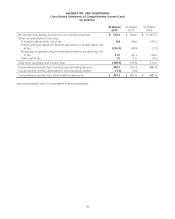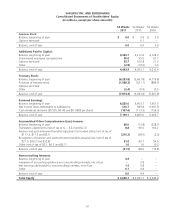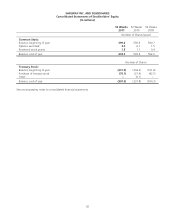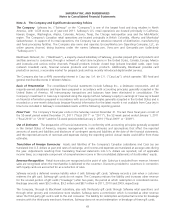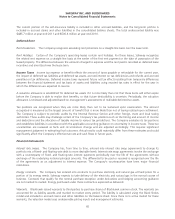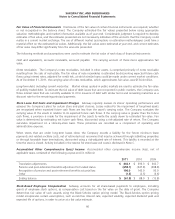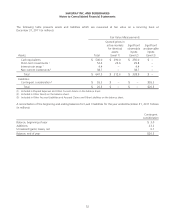Safeway 2011 Annual Report Download - page 63
Download and view the complete annual report
Please find page 63 of the 2011 Safeway annual report below. You can navigate through the pages in the report by either clicking on the pages listed below, or by using the keyword search tool below to find specific information within the annual report.SAFEWAY INC. AND SUBSIDIARIES
Notes to Consolidated Financial Statements
The current portion of the self-insurance liability is included in other accrued liabilities, and the long-term portion is
included in accrued claims and other liabilities in the consolidated balance sheets. The total undiscounted liability was
$485.7 million at year-end 2011 and $506.4 million at year-end 2010.
Deferred Rent
Rent Escalations. The Company recognizes escalating rent provisions on a straight-line basis over the lease term.
Rent Holidays. Certain of the Company’s operating leases contain rent holidays. For these leases, Safeway recognizes
the related rent expense on a straight-line basis at the earlier of the first rent payment or the date of possession of the
leased property. The difference between the amounts charged to expense and the rent paid is recorded as deferred lease
incentives and amortized over the lease term.
Income Taxes Income tax expense or benefit reflects the amount of taxes payable or refundable for the current year,
the impact of deferred tax liabilities and deferred tax assets, accrued interest on tax deficiencies and refunds and accrued
penalties on tax deficiencies. Deferred income taxes represent future net tax effects resulting from temporary differences
between the financial statement and tax basis of assets and liabilities using enacted tax rates in effect for the year in
which the differences are expected to reverse.
A valuation allowance is established for deferred tax assets if it is more likely than not that these items will either expire
before the Company is able to realize their benefits, or that future deductibility is uncertain. Periodically, the valuation
allowance is reviewed and adjusted based on management’s assessments of realizable deferred tax assets.
Tax positions are recognized when they are more likely than not to be sustained upon examination. The amount
recognized is measured as the largest amount of benefit that is more likely than not of being realized upon settlement.
The Company is subject to periodic audits by the Internal Revenue Service and other foreign, state and local taxing
authorities. These audits may challenge certain of the Company’s tax positions such as the timing and amount of income
and deductions and the allocation of taxable income to various tax jurisdictions. The Company evaluates its tax positions
and establishes liabilities in accordance with the applicable accounting guidance on uncertainty in income taxes. These tax
uncertainties are reviewed as facts and circumstances change and are adjusted accordingly. This requires significant
management judgment in estimating final outcomes. Actual results could materially differ from these estimates and could
significantly affect the Company’s effective tax rate and cash flows in future years.
Financial Instruments
Interest rate swaps. The Company has, from time to time, entered into interest rate swap agreements to change its
portfolio mix of fixed- and floating-rate debt to more desirable levels. Interest rate swap agreements involve the exchange
with a counterparty of fixed- and floating-rate interest payments periodically over the life of the agreements without
exchange of the underlying notional principal amounts. The differential to be paid or received is recognized over the life
of the agreements as an adjustment to interest expense. The Company’s counterparties have been major financial
institutions.
Energy contracts. The Company has entered into contracts to purchase electricity and natural gas at fixed prices for a
portion of its energy needs. Safeway expects to take delivery of the electricity and natural gas in the normal course of
business. Contracts that qualify for the normal purchase exception under derivatives and hedging accounting guidance
are not marked to market. Energy purchased under these contracts is expensed as delivered.
Warrants. Blackhawk issued warrants to third parties to purchase shares of Blackhawk common stock. The warrants are
accounted for as liability awards and marked to market every period. The liability is calculated using the Black-Sholes
model and included in accrued claims and other liabilities on the balance sheet. Since there is no active market for these
warrants, the valuation model uses unobservable pricing inputs and management estimates.
45



